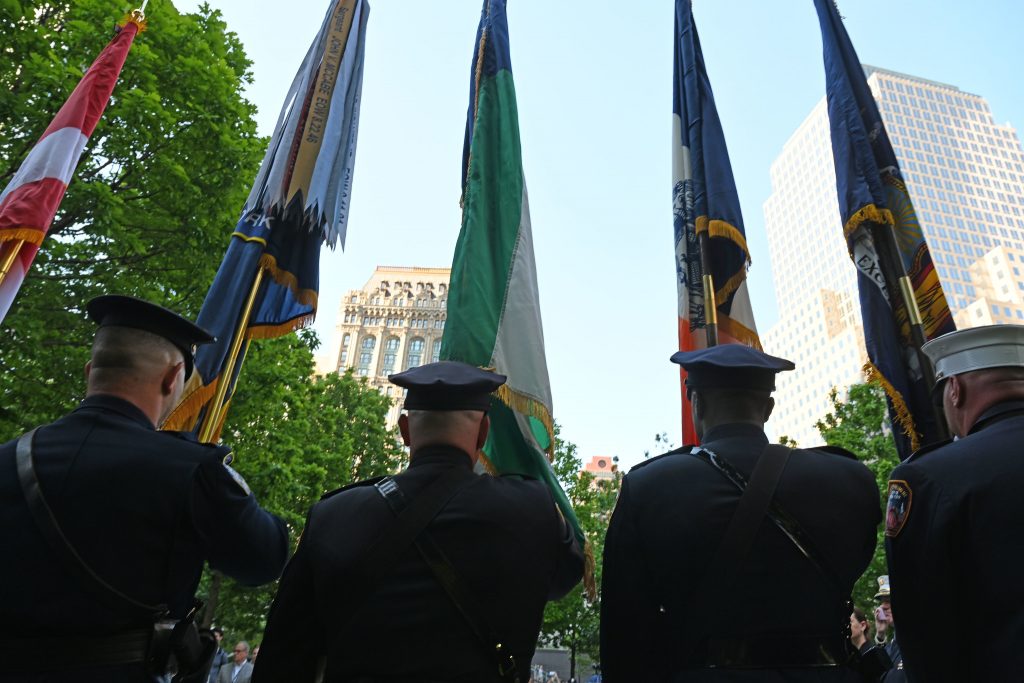
New York City, NY, September 13, 2001 — The sun streams through the dust cloud over the wreckage of the World Trade Center.
On the 21st anniversary of 9/11, lawmakers and union leaders are trying to reach those “forgotten workers” who worked at Ground Zero and in nearby neighborhoods to clean up lower Manhattan in the months and years that followed.
Thousands of civilian employees such as construction workers involved in the massive cleanup of Ground Zero are eligible for World Trade Center victims’ health coverage, but have not yet registered for benefits.
lawmakers, union leaders and legal advocates are calling for public hearings and passage of legislation that would require employers to make their employees aware of their eligibility in the health coverage program.
Assemblyman Nader Sayegh, D-Yonkers, has proposed the 9/11 Notice Act (A.9715) to aid the many still in need of help. Brian Kavanagh introduced the Senate version of the bill (S. 9551).
This legislation would require businesses with 50 or more employees that were in operation between September 2001 and May 2002 in and around Ground Zero to notify current and former employees of their qualification to register for benefits under the James Zadroga 9/11 Health and Compensation Reauthorization Act.
The bill would also reauthorize the former World Trade Center health care program for an additional 75 years, sunsetting in 2090. The bill would offer a wide array of health care covering all costs related to hospitalizations, treatments, and medications to all enrolled.
“Not all of our 9/11 heroes wore uniforms. Those who came back to their jobs south of Canal Street and got New York’s, moving again are also heroes, and they breathed the same toxic air as our first responders,” said Assemblyman Sayegh. The U.S Army Corps of Engineers finds that individuals such as first responders, civilian employees, construction workers and many other individuals are among the affected groups this legislation seeks to find.
While most uniformed emergency responders have enrolled in the World Trade Center Health Program, it is estimated that only 10 percent of other workers and citizens who would qualify for the coverage have enrolled.

James Zadroga was a New York City Police officer who escaped the World Trade Center during its collapse. Zadroga had given countless hours to assist in the cleanup of Ground Zero assisting in various rescue and recovery operations. Zadroga died in 2006 and is among the first to succumb to an illness directly caused by the unsafe conditions at Ground Zero.
According to the bill’s memo, in the aftermath of the 9/11 terrorist attacks, people who worked in the “Exposure Zone” south and west of Canal Street from the Hudson River to the intersection of Canal Street and East Broadway were subjected to toxic pollutants in the air which in time have proven to be harmful to their health and wellbeing.
“I will never forget the smell of burning metal and the sight of the chalky dust cloud that engulfed Lower Manhattan after the terrorist attack on 9/11,” said Assemblyman J. Gary Pretlow, D-Mt. Vernon, a supporter of the legislation. “More than two decades later, the potent smell and powdery dust are gone; however, the effects of the toxins still linger, causing more than 4,600 deaths since 9/11—more than the death toll on that terrible day,” Pretlow said.
In the 21 years since the attack, 4,610 deaths have occurred, far surpassing the 2,966 people who died that day.
The bill is supported by 9/11 legal advocate Michael Barasch, managing partner of the Barasch & McGarry law firm, as well as union leadership such as Louis Coletti, president and CEO of the Building Trades Employers Association. Coletti represents 1,200 union construction contractors, many of whom helped clean up lower Manhattan after Sept. 11.
“There are estimates that about 3,000 construction workers were involved in the cleanup of the World Trade Center after 9/11,” Coletti said. “Very few are aware that the health coverage provided to emergency responders is available for them as well. I urge anyone who worked here during the recovery to register. Cancer and other serious illnesses caused by toxins can take years to develop, and we should take every step necessary to notify people who are eligible for protection.”
September 11 first responders in uniform are the current largest demographic receiving aid from the program, a statistic that Assemblyman Sayegh and Assemblyman Pretlow hope to change. Their goal is to make sure that the estimated remaining 90 percent of all workers and citizens who would qualify are aware of the help that exists for them.
“Patients are often left with huge bills they cannot afford, averaging $42,000 in the year following a cancer diagnosis. The new legislation is designed to locate lost 9/11 victims, as much as 400,000 people, to let them know they have a lifeline and do not have to drown in debt while gaining access to life-saving treatments on the road to recovery,” Pretlow said.









